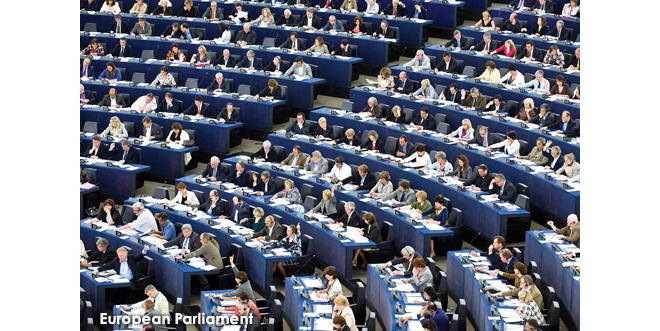Europe's online source of news, data & analysis for professionals involved in packaged media and new delivery technologies

FEATURE: The Anti-Counterfeiting Trade Agreement - fighting IPR infringements
Among many governments, NGOs and businesses, there is general agreement that counterfeiting and other commercial intellectual property rights infringements are wrong. The hard question is what to do about them. JIM BURGER, Partner at US law firm Dow Lohnes, reflects on the Anti-Counterfeiting Trade Agreement, and whether it could balloon out of control.
Started by the United States and Japan, the development of the Anti-Counterfeiting Trade Agreement (ACTA) was joined by nine other countries (Canada, the European Union, Switzerland, Australia, Mexico, Morocco, New Zealand, South Korea, Singapore). What made it more complex were the different levels and systems of national Intellectual Property Rights (IPR) protection.
Also, what made ACTA more controversial than most IPR treaty negotiations was that the negotiations were officially ‘secret’ trade negotiations. Secret is in quotes because drafts of the treaty were regularly leaked to the public. In general, however, the treaty’s goals and provisions were supported by most. Nevertheless, interim versions of the treaty and the final draft contained provisions that many found objectionable, including some that might require changes in national laws; this despite the repeated assurances the treaty would not require any such changes.
Secret Talks
Most intellectual property treaties have been negotiated in an open multilateral environment and generally set rules at a reasonably high enough level so that any required changes could be made consistent with domestic law. An example would be the GATT Agreement on Trade-Related Aspects of Intellectual Property Rights.
In the past, many multilateral IPR treaties were negotiated in the World Intellectual Property Organization WIPO, which provides for non-governmental organisations (NGO) involvement, and drafts are usually available to those entities and other stakeholders.
Some believed that ACTA bypassed WIPO because of the concern that the opportunity for public review slowed down if not stymied reaching agreement on strong enforcement treaties. Trade agreements, at least under US law, are negotiated on a bilateral basis and the negotiations are secret. Only so-called ‘Cleared Advisors’ are allowed to see drafts, and they are required to keep drafts confidential. This makes sense in the context of negotiating hard goods trade deals (e.g., lifting wheat quotas, or eliminating onerous import requirements designed to hinder trade).
As leaked information about the ACTA negotiations and drafts began to circulate, and many felt that rules were being negotiated that would negatively impact individuals and corporations across the board, there were many protests and requests to open the negotiations. But because of legal requirements covering trade negotiations, the US and other countries could not readily share ‘secret’ drafts.
The United States Trade Representative charged with negotiating trade agreements, ultimately found a way to disclose draft language to stakeholders within the legal requirements by having NGO and company representatives sign a non-disclosure agreement. A final draft is publicly available here.

Initial Issues
Multinational companies and some NGOs had two major issues with earlier drafts: secondary liability/statutory damages and online service provider liability.
Secondary liability/Mandatory damages. ACTA would have required each party to agree to adopt US forms of secondary liability, defined as contributory, vicarious, and inducement, subject to limitations and exceptions, if any, in their national laws. While one leaked draft Internet chapter inclu-ded the three current US judicially-imposed secondary copyright liability theories, it lacked the specific conditions and limi-tations imposed on liability by the US Copyright Act and US secondary liability cases.
The primary issue was the danger to legitimate commerce that could have been caused by linking secondary liability, without fair use or its equivalent, with mandatory damages, and quite different theories of secondary liability that existed in the other ACTA countries.
To be liable for secondary liability in the US, someone has to have used your service or product to directly infringe a rights holder’s copyright. The balance in US law is that as long as one doesn’t actively induce the direct infringement or directly contribute, and the service or product is merely capable of non-infringing use, there is no secondary liability.
In the landmark 1983 Sony case, the Supreme Court applied the fair use test to the alleged direct infringement and found that because the VHS recorder was being used for the ‘fair use’ of time-shifting copyrighted television programmes, Sony was not guilty of secondary liability; even though there were users that employed the VHS to directly infringe.
In many ACTA countries there is a well-developed secondary liability authorisation regime. In those cases the courts have generally held that there needs to be more than just supplying a service or device which is used to infringe; i.e., an entity is secondarily liable (or may have secondary liability) if it has dominion over the direct infringer, ‘authorises’ the infringement, and profits from the infringement.
Moreover, most of the ACTA countries do not have an equivalent defense (or non-infringement) theory similar to the US fair use doctrine. Combined with mandatory damages, this could have significantly chilled innovation in the other ACTA countries. In many other ACTA countries a rights holder may collect only actual damages. Ultimately, after lobbying by NGOs, international consumer electronics and informa-tion technology companies, the provision was removed and parties could still have a system of actual, rather than mandatory damages.
Online Service Provider liability. In the US, a complex compromise between online service provider (OSP) and content providers was embodied in the OSP safe harbor section of the Digital Millennium Copyright Act. This is a complex multi-page set of provisions granting OSPs a safe harbor from copyright infringement resulting from their customers’ infringing online acts; provided the OSP complies with a notice and take down regime.
Initial drafts of ACTA contained an abridged version of the US safe harbor provisions. As one can imagine, they could not and did not capture the important, but subtle agreements reflected in the US law. The result in the Final Agreement, after significant discussions in many ACTA country capitals, was language permitting parties to order an OSP to provide to the rights holder the identity of an alleged infringer-customer with appropriate safeguards.
Compatibility with national law
Academics and others in the European Union, Canada, and the US (and likely other ACTA countries) are troubled by a number of ACTA’s provisions in the Final Agreement. Indeed, recently the Mexican Senate voted against ratifying ACTA.
A group of European academics published a ‘non-exhaustive’ list of ten provisions incompatible with EU law in the final Agreement. The following is a summary of the civil enforcement issues:
Injunctions. ACTA requires a country to grant injunctive relief to halt infringing activity. The scholars were concerned that this might wipe out monetary compensation as an alternative. In the US, for example, under the four-factor test, injunctions are routinely granted in copyright cases where the plaintiff demonstrates it is likely to succeed on the merits, even if it could be made whole by monetary damages.
Damages. As noted above, many stakeholders had problems with the initial damages provisions. The academics maintains that some of the damages criteria in ACTA are absent in the EC IPR Directive and the ACTA requirements could be read to raise the level of damages beyond what was contemplated in the Directive.
Other remedies. The concern here is that in comparison with the Directive, ACTA shifts the focus to destruction of infringing goods from disposal of outside the channel of commerce, the caveat of proportionality in the Directive is omitted, and non-infringing third parties interests may not be protected.
Provisional measures. As the US Supreme Court has stressed, the European Court of Justice has stressed balance in applying IPR: noting that procedural guarantees are important to ensure that a balance is maintained between the competing rights and obligations of the right holder and of the defendant. The academics have a hard time accepting ACTA’s providing provisional measures inaudita altera parte (in the US ex parte) in that ACTA lacks the Directive’s procedural guarantees permitting parties to challenge the measures later.

The academics also had a series of concerns about border measures:
Definition. Their concern is about potential misuse of the border provisions in that EU regulations limit border measures to counterfeit goods. ACTA uses the broad terms ‘intellectual property rights.’ They are rightfully concerned this provision could be applied beyond real counterfeiting to disputes such as confusingly similar trademarks and trademark dilution.
No EU Acquis on criminal measures. Unlike US law, the academics state that there are currently no EU IPR criminal enforcement provisions; accordingly, this would require EU level legislation.
Scope. ACTA casts the net of ‘commercial scale’ quite broadly including acts carried out for direct or indirect commercial advantage. The European Parliament, however, had excluded from liability acts ‘carried out by private users for personal and not for profit purposes.’
Parallel imports. The concern here is that, unlike the European position, ACTA provides for criminal procedures and penalties for the willful import and domestic use of goods infringing a trademark; and, this could hinder parallel imports in the EU. More readily termed ‘grey market’ goods in the US, US law has traditionally be neutral with respect to parallel imports that are not manufactured for a specific geography outside the US.
Cinematographic works. While ACTA’s criminal measures for unauthorised reproduction of movies are optional, the Agreement suggests that such acts be made criminal without requiring some measure of commerciality.
Safeguards. The academics echo a statement often made by NGOs, while strengthening the IPR holders rights, ACTA does not provide any of the safeguards needed to ensure the balance of interests between parties and guarantee a due process. ACTA does not guarantee the alleged infringer the right to be heard in seizure, forfeiture, and destruction orders proceedings.
In addition to the academics, last month a study commissioned by the European Parliament Committee on International Trade concluded that ACTA was more ‘ambitious’ than EU law and created risks for access to medicines.
A number of Canadian commentators have spoken out about ACTA. Canada is still, and has been for a while, in the middle of revamping its copyright laws to bring them into accordance with WIPO’s Copyright Treaty and the World Performance and Phonograms Treaty, which it signed in 1997. Nevertheless, the concern of Canadian academics and lawyers is that ACTA would require major changes to its legal system: ‘The proposed treaty would import into Canadian copyright law notions that are not in harmony with its purpose, provisions, and/or judicial interpretation.’
Similar to European comments, in the US organisations have expressed concerns about the broad scope of the ‘infringement’ and ‘intellectual property’ definitions that could be interpreted inconsistent with US law. As noted above, concern in the US, in part, is centered on the use of intellectual property as including any more than ‘trademark counterfeiting’ or ‘copyright piracy.’ If interpreted broadly, the ACTA definition would transform what are common non-counterfeit-types of civil action infringement cases into activity that could be punished under federal criminal law in the US or other ACTA countries.
Also similar to the European commentors, US concern is that the implementation of ACTA should reflect the goal of the Agreement: actual anti-counterfeiting. Thus, the text should only apply where the infringement is on a commercial scale.
Conclusion
What started out with quite laudable goals – the prevention of actual counterfeiting and commercial-scale copyright infringement – ACTA seemed to balloon almost out of control.
Rather than focus on dangerous counterfeits, the Agreement appears to have swung towards protecting entertainment content. As the former government Department of Homeland Security official Stewart Baker said: “It seemed like a sweetheart deal for a few intellectual property owners, who’d get free government enforcement of their private rights, potentially to the detriment of security and traditional customs enforcement. Worse, the sweetheart deal would be written into international treaty, putting it beyond Congress’s reach if the risks we foresaw actually came to pass.”
The hope is that the countries that do sign and implement ACTA do so with the goals of ACTA foremost in mind: ‘to deal with large-scale intellectual property infringements, which can frequently involve criminal elements and pose a threat to public health and safety.’

JIM BURGER, a Dow Lohnes partner, represents technology companies on IP, communications, and government policy. He was a Senior Director in Apple's Law Department. Jim received his Law (cum laude) degree from NYU Law School, and was editor of the NYU Law Journal. Contact: jburger@dowlohnes.com
This is one of many editorial features included in the annual DVD and Beyond 2011 magazine. Ask for your free copy.
Story filed 27.10.11



















